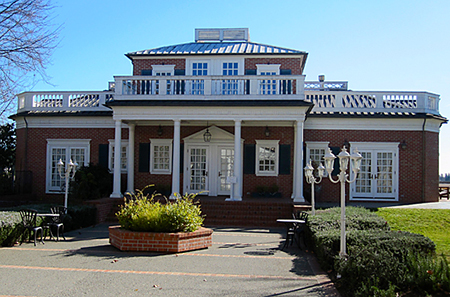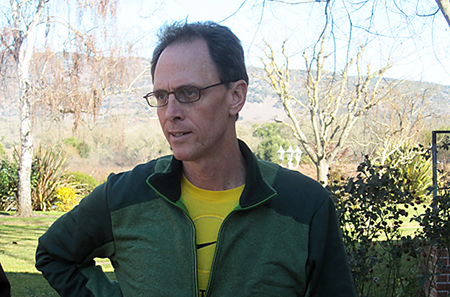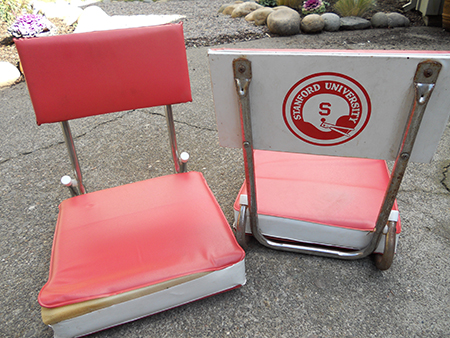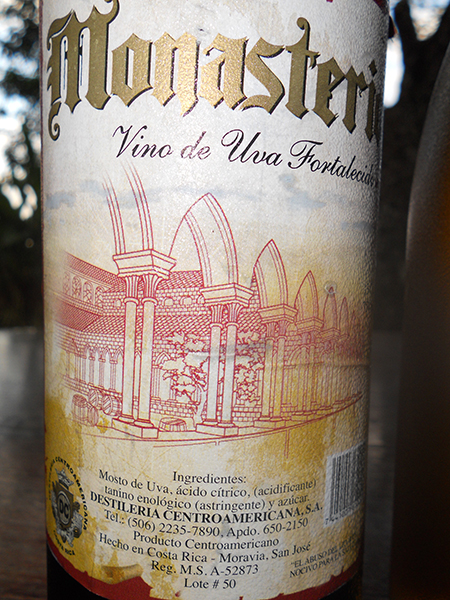Monticello Vineyards experiments with wine flavored cheese
"Guest Blog : Posted on January 26, 2012 by Ray
This is a guest blog post by Vintage Wine Taster and good friend Ray Conti. Ray and his wife recently took a trip to the Monticello winery on Big Ranch Road in the Napa Valley. They escorted two friends who own a dairy near Santa Fe, New Mexico.
Their two Santa Fe friends, Ed & Michael Lobaugh, own The Old Windmill Dairy® just outside of Santa Fe, New Mexico. They make a wonderful variety of artisan goat and cow cheeses. At a Wine & Cheese festival in Carlsbad, Monticello Vineyard's Stephen Corley approached them and indicated the winery might be interested in combining the Monticello wines with their Gouda cheeses. Monticello sent a case of their wines containing three varietals: Estate grown Chardonnay, Pinot Noir, and Cabernet Sauvignon.
About Monticello Winery
Monticello is a small winery by Napa standards (15,000 cases), but their quality makes up for the small quantity. Jay Corley founded the winery in 1970 and today sons Kevin, Stephen and Chris Corey are operating the winery. Kevin oversees the operation, Stephen is in charge of sales, and Chris is the winemaker. The winery lies just above the town of Napa. It is on Big Ranch Road that can be accessed from Oak Knoll Road. They have three lines of wine: Corley Reserve, Corley Family wines, and Monticello Reserve wines. Their specialties are Cabernet, Pinot Noir, Merlot and Chardonnay. The friendly tasting room is opposite a 1/3 scale replica of Jefferson's Monticello; a tribute to America's first serious wine collector. This is a fun place to start a wine tour of the Napa Valley
About the Cheese Project
This is the process used to infuse the Monticello wines into the Gouda cheese. After the initial stages to develop the curd from the cow's milk, the mixture is pressed into wheels. After 12 hours the cheese hardens sufficiently it is removed from wheels and is transferred to a vat brine mixture of wine, salt and purified softened water. After several days the cheese is then removed and dried on a rack at room temperature. All these steps are done by hand and the length of time is determined by how the cheese feels to the touch and how it tastes and smells. Once the cheese develops an oily dark surface, it is hand waxed with a clear wax and than a dark red wax. After the wax is dry, the cheese is transferred to an underground cellar and aged at a temperature of 54 degrees Fahrenheit. The Monticello cheeses were aged for 60 days. The flavor results in a moister, creamier yet mild flavored Gouda. When aged for approximately 5 months, the cheese will develop a more robust flavor. Each of the Monticello wines will create a very different flavor in the Gouda cheese.
This is an ongoing project with much experimentation to get the perfect wine-flavored Gouda cheese. Ed & Michael Lobaugh are eagerly waiting to see what the Corley family thinks of this young batch of Gouda. The hope is that the project will result in cheeses the Corely family will want to feature in their tasting room and possibly sell to Napa Valley restaurants. We will be sure to get back to you when the results are in and indeed if this Gouda is available for sale.
"
1981-2011 : On The Field and In The Field
"Posted By : Chris Corley
On January 10, 1982, Dwight Clark made The Catch. It was immediately the defining moment and iconic image of the rising star of the 49ers. At this same time, the inaugural 1981 vintage of Monticello Cellars Cabernet Sauvignon was residing in small french oak barrels in Napa Valley. Ultimately, the 49ers won their first Super Bowl, and our 1981 vintage ended up being labeled in red and gold. For both the 49ers and Monticello Cellars, the 1981 season was the culmination of perseverance, execution and a dose of good fortune. For both the 49ers and Monticello Cellars, the 1981 season marked the beginning of a wonderful run for the red and gold ...
Our dad, Jay Corley, was a colleague of Lou Spadia, when Lou was the president of the 49ers in the late 1960s and early 1970s. While Jay was busy getting Monticello Vineyards started in Napa Valley, Lou was working on making the 49ers be the best they could be, having been with the team since 1946 before rising to become president. Jay would attend games at Kezar Stadium as a guest of Lou's, and when the 49ers were gearing up to move to Candlestick Park, my dad mentioned to Lou his interest in procuring season tickets. Lou asked where he wanted to sit, and our dad said, ""On the fifty yard line and in the sun."" Done. The Corley Family has been cheering the 49ers from LE Section 31, Row 23, Seats 9-10 since the 49ers moved into Candlestick Park.
There are some correlations between football and winemaking that are not immediately apparent. We talk about both in terms of seasons or vintages. We celebrate the 1981, 1984, 1988, 1989, 1994 (and hopefully 2011) seasons of the 49ers for the exciting Super Bowl victories. In the same way, we celebrate the best of our winemaking vintages ... in Napa Valley, for example, 1995, 1997, 1999, 2002, 2005, 2007, 2008 Cabernet Sauvignon. In between the celebrated vintages are seasons that may be less exciting or even sometimes disappointing. We've certainly sat through some difficult seasons at Candlestick, but we've always kept the faith with the team and cheered them on regardless of the circumstances. I imagine we have some long time Monticello fans that get more fired up about the celebrated vintages than others. Thats okay, and its the nature of both wine and football. The important thing is, in the long run, they are still Monticello Faithful and are still excited about what we do.
In a way, this 2011 49ers season reminds me of the 2005 vintage in Napa Valley. We were excited to have Jim Harbaugh at the helm. Our dads a Stanford grad, so we follow the Cardinal, their last few seasons with Harbaugh and Luck have been as exciting as any recently. We used to go to the games at the old Stanfor Stadium when John Elway was tossing balls to a very acrobatic Kenny Margerum. My mom recently dug out those old rusty Cardinal seatbacks for those old wooden Stanford benches. Now we use them to watch my son Jackson play for the Napa Saints.
Anyway, I digress. With Harbaugh on board, my personal forecast for 2011 was that the 49ers might go 9-7 and hopefully get into the playoffs. As each game was played, it just kept working out, and the Saints-49ers divisional matchup was the most exciting 49ers game I've watched in the last 15+ years. The season just kept developing and the 49ers kept figuring out ways to win, with great team play. The 2005 vintage in Napa Valley was similar. The season started out with good expectations, but nothing that foreshadowed greatness. As the cool season continued, and we kept sampling and tasting the fruit, we began to realize that we really had something special developing. The fruit kept hanging and improving, and by the time we picked, we knew we had a great vintage on our hands. Things sometime just work out both on the field and in the field in ways that are not foreseen.
Today, I'm a little reflective thinking about the parallels of the last 30 years of 49ers football and Monticello Vineyards winemaking. Tomorrow, my brother Stephen and I will be at the NFC Championship game. Look for us on the TV. We'll be the two guys in red and gold cheering loudly. We just might need to dig out a dusty bottle of 1981 Monticello Cabernet Sauvignon next week and celebrate this season, regardless of tomorrows outcome. Somehow that seems appropriate ...
For now, Lets Go Niners!
"
Costa Rica : Fruit Wine & Indian Masks
Posted By : Chris Corley
We're currently in Costa Rica and have enjoyed a nice week in Playa Pochote, which is considered a town here, but really is more like 100 or so locals that live near each other and a campground where the 'ticos' from San Jose come to beach camp for the weekend. The local services in ""town"" include a payphone.
I had zero expectation of finding any local wines in Costa Rica, so didn't even think much about it. I was ready to spend my time guzzling Imperial lagers in the sun and looking forward to the fresh fish. To my surprise, when we went to the little village market in the next 'town' called Tambor, the fellow in the store directed towards the the surprisingly well stocked wine aisle, where I found several Costa Rican wines.
It struck me at that moment, that my subliminal notion of wine automatically referenced my own experiences, that is grape wine. There were actually shelves full of all sorts of local wines - fruit wines - pineapple, orange, and grapes too. My interest in traveling is in tasting the local efforts. I didn't come all this way to drink and eat things I can get at home. So I loaded up a few bottles of the local wines and headed home, excited to taste these wines.
Please keep in mind, I'm a winemaker, not a critic nor a winewriter. I'll just stick to describing rather than critiquing. At these wineries in Costa Rica, no doubt there are a group of people of that are trying to do the best they can with what they've got, and I have no interest in disparaging their or anybodys efforts, regardless of the results.
SAN PEDRANO 'VINO DE NARANJA' - I'm not really sure what I was expecting before tasting wine made from oranges, but I was a little surprised when I poured it in the glass and it looked like a slightly oxidized white wine. The aromas were not nearly as strong orange as I anticipated. The wine was pleasant on the palate, with a nice acidity, basically dry (no residual sugar), and was not as strong in orange flavor as I thought it would be. This wine would be a good match for a bowl of fresh ceviche on the beach, and I wouldn't be surprised if thats the way its most commonly consumed.
SAN PEDRANO 'VINO DE PINA' - This wine was the most enjoyable for just sipping on by itself. The aromas and flavors of pineapple were much stronger than in the orange wine. The nature of the pineapple tones kind of lent themselves to a refreshing tropical drink. The texture, just like the orange wine, was more similar to grape white wine than I was expecting. The wine was visually clean as though it had been filtered, or at least fined very well. The texture was not viscous or syrupy at all, like pineapple juice can be. Chilled, this was my favorite of the three.
MONASTERI 'VINO DE UVA' - This wine was interesting to taste. Its the one wine we found that was actually made from grapes. It was difficult to discern any particular fruit flavor from the wine. The acidity was a little tart and out of balance, likely due to the citric acid addition mentioned in the ingredients. This was somewhat balanced by the residual sugar. This wine was interesting to taste and I think would be best served chilled and with some really spicy food.
On a completely unrelated-to-wine note, I've got take a moment to talk about some artwork that we came across here in Costa Rica. My wife, Julianna, and I have for years enjoyed collecting masks. We try to collect one at every destination, whether its an old Indian ceremonial mask at the pueblo in Taos, a cloth spiritual mask in Peru, or a simple wooden mask from Isla Roatan. They're great personal reminders of shared adventures, and if chosen well, can be very reflective of the culture. We've got a growing wall full of them in our dining room at home.
That said, in Costa Rica, we've come across some of the most ornate masks yet. They are made by the Boruca Indian tribe, an indigenous people of Costa Rica. They are carved of balsa wood, so are soft and light. The carving is very impressive, but the intricacy and vibrancy of the painting is extraordinary. The masks are carved and painted so vividly to represent the devil and originally were utilized to scare off the invading Spanish conquistadors. These are the most colorful and vibrant masks we have personally come across, and its reassuring knowing that some of the proceeds from the sales of the mask go back to help fund the preservation of the Boruca Indian culture, which there are only about 2000-2500 living Borucan Indian tribemembers on the reserve. The tribe hosts a festival around New Years, the 'Danza de los Diablitos', reenacting the war between the indians and the conquistadors. The indians win ...
My First Brazilian
"Posted By : Chris Corley
We've spent the last ten days in Brazil enjoying the holidays. This is our first time in Brazil. We've really enjoyed the people, the food and the warm December weather. We've also found Portuguese to be one of the more difficult languages to grasp. Despite having reasonable Spanish skills which serve me well in Mexico, I found myself often staring blankly when spoken to in native Portuguese, even when conducting simple transactions. The language sounds to my ears like an indecipherable mix of Spanish, French, Italian and Japanese. We didn't pack a Babel Fish either. Very few people that we have encountered speak English, and most of them were a younger generation that no doubt are taking English classes.
We've enjoyed trying the local foods and wines. One of our favorite dishes has been Baiao de Dois, which is kind of like a paella dish. Lots of rice, beans, sausage, linguica, cheese and mandioca (cassava), which is fibrous potato-like vegetable that was really good and added a nice texture to the plate.

MANDIOCA
The local fruit juices have been a real treat as well. I particularly enjoyed the juices of the Umbu and Graviola, both native fruits to Brazil, which to the best of my understanding don't grow anywhere else. Both juices were white and milky in texture. The Umbu was more tart and the Graviola had a creamy tone to it. Both were very good on their own, and I imagine would be great mixers for your favorite rum.
UMBU
We have also enjoyed trying out some of the local wines. There are some local wines known as 'country wines' that are primarily poured by the glass. these wines are generally lower quality and I didn't care for them. I'm also not a critic, and not interested in disparaging my fellow winemakers, so I'll just comment on a few wines that I found of interest during our visit. On the map below, you can see the major wine regions of Brazil. The lower regions roughly line up horizontally with some of the winegrowing regions in Uruguay, Argentina and Chile. Interestingly, we had a tough time finding many Brazilian wines in stores. Most the wines we've seen on the shelves in South America, and perhaps not surprisingly, have been from Chile and Argentina.

MIOLO 'Reserva' 2010 Cabernet Sauvignon (Camphana) - This wine had dark berry flavors and well extracted tannins. Full bodied and plenty of lively acidity, this wine was best enjoyed with a meal (Baiao de Dois?) rather than on its own.
DUETTO 2010 Cabernet Sauvignon & Merlot (Vale dos Vinhedos) - This wine had a little reduced (stinky) tone when we popped the cork, but it quickly opened up with some air. It had a softer texture and a fuller body than the Miolo. The fruit and acidity were a little muted but this was the best wine for just having a glass on its own.
CASA VALDUGA 'Premium' Chardonnay (Vale dos Vinhedos) - This Chardonnay had very bright acidity and the green apple flavors made it taste more like a Sauvignon Blanc than a Chardonnay. Crisp and refreshing, this half-bottle disappeared pretty quickly.
We've enjoyed are our visit to Brazil and have been introduced to many new tastes, textures, sights and sounds. I hope you've enjoyed reading about a few of the highlights."










